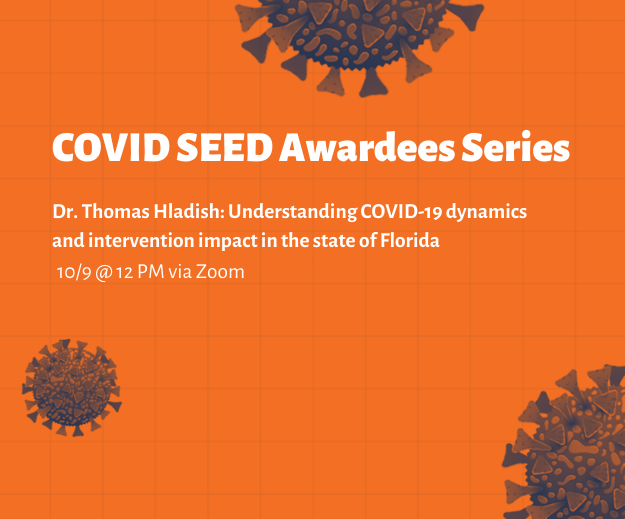UFII Covid Seed Awardees Virtual Seminar Series – Dr. Thomas Hladish

- This event has passed.
UFII Covid Seed Awardees Virtual Seminar Series – Dr. Thomas Hladish
October 9, 2020 @ 12:00 pm - 1:30 pm

UFII Covid Seed Awardees Virtual Seminar Series
“Understanding COVID-19 dynamics and intervention impact in the state of Florida: An agent-based modeling approach” by Dr. Thomas Hladish
Assistant Research Scientist in the Department of Biology and Emerging Pathogens Institute
Friday, October 9, 2020
ABSTRACT:
Understanding COVID-19 spatiotemporal dynamics requires a detailed understanding of population interaction patterns, heterogeneities in risk, and temporal changes in interventions and behaviors. To better understand what has happened with COVID-19 in Florida, and to predict future dynamics and intervention impact, we have developed a spatially-explicit synthetic population representing the state’s population, including 21m people residing in 11m households and 3.8k long term care facilities, who go to work in 2.3m workplaces and attend 7.6k schools. Individuals in the model have attributes including age, sex, and presence of comorbidities. This approach requires sourcing, reconciling, and integrating datasets from the U.S. Census (household composition), National Corporation Directory (workplace type and location), CDC (comorbidities), and SafeGraph (behavioral changes), among others. We then use this synthetic population as an input to the agent-based model we developed of SARS-CoV-2 transmission and COVID-19 detection and reporting. Using this model, we have predicted the impact of a range of interventions the state of Florida might have employed thus far, as well as the impact of a range of vaccination scenarios that may become available in the coming months.
Bio:
Dr. Thomas Hladish is an assistant research scientist in the Department of Biology and Emerging Pathogens Institute. Using simulations and mathematical models, he studies the temporal and spatial dynamics of infectious diseases, including COVID-19, dengue, influenza, polio, Ebola, and cholera, with a particular focus on how imperfect interventions might best be used to control disease. Dr. Hladish’s work has influenced international vaccine policy, and he has collaborated with the WHO, Florida Department of Health, and Texas Department of State Health Services, and has been interviewed by local and national media outlets including CNN, NPR, New York Times, Wall Street Journal, Washington Post, and Tampa Bay Times. He is the author of several software projects to facilitate research in computational epidemiology, including AbcSmc, a toolkit for parallelized Bayesian parameter inference of stochastic models, and EpiFire, a contact network-based library for constructing populations and simulating disease transmission.

